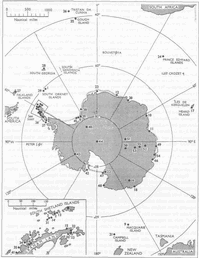


Memories of the Bureau, 1946 to 1962
Foreword
Terminology
Prologue
Preface
Chapter 1: The Warren Years, 1946 to 1950
Chapter 2: International Meteorology
Chapter 3: The Timcke Years, 1950 to 1955
Chapter 4: A Year at the Massachusetts Institute of Technology
Chapter 5: The Dwyer Years, 1955 to 1962
Leonard Joseph Dwyer—A Complex Character
Reorganising the Bureau
Public Weather Services
Forecasts for the General Public
Importance of Radio Stations
The Advent of Television
Automatic Telephone Forecast Service
Beacons
Wording and Verification of Forecasts
Warnings
Services for Aviation
Atomic Weapons Tests
Atomic Weapons Tests—Mosaic G1 and G2
Atomic Weapons Tests—Buffalo 1, 2, 3 and 4
Atomic Weapons Tests—Operations Antler, 2 and 3
Atomic Weapons Tests—Minor Trials
Instruments and Observations
Radiosondes
Radar/Radio Winds and Radar Weather Watch
Automatic Weather Stations
Sferics
Meteorological Satellites
Telecommunications
Tropical Cyclones
Bureau Conference on Tropical Cyclones
International Symposium on Tropical Cyclones, Brisbane
Hydrometeorology
Design of Water Storages, Etc
Flood Forecasting
Cloud Seeding
Reduction of Evaporation
Rain Seminar
Cloud Physics
Fire Weather
Research and Special Investigations
International Activities
The International Geophysical Year
The Antarctic and Southern Ocean
International Symposium on Antarctic Meteorology
International Antarctic Analysis Centre
ADP, EDP and Computers
Training
Publications
Management Conference
Services Conference
CSIRO and the Universities
Achievements of the Dwyer Years
Chapter 6: A Springboard for the Future
Appendix 1: References
Appendix 2: Reports, Papers, Manuscripts
Appendix 3: Milestones
Appendix 4: Acknowledgements
Appendix 5: Summary by H. N. Warren of the Operation of the Meteorological Section of Allied Air Headquarters, Brisbane, 1942–45
Endnotes
Index
Search
Help
Contact us

International Symposium on Tropical Cyclones, Brisbane (continued)
The paper on storm surges by D. Lee Harris did not excite the reaction it deserved, possibly because it was in one of the later sessions of the symposium and by that stage participants were becoming weary after four days of sessions with social occasions in the evenings. I can still remember the reception by the Lord Mayor of Brisbane and the various other social occasions, particularly some hospitality offered at the home of Allen Bath which was a particularly jolly affair.The chairmen of the various sessions were John Gabites, Dr Fletcher, Prof Herbert Riehl, Bill Priestley, Commander Brango, Colin Ramage and myself (two sessions). I also chaired the final session which was devoted to summing up by a panel of Brango, Fletcher, Jamison, Palmen, Ramage and Riehl. This panel discussion emphasised the need for further research to establish the mechanism of development and movement of tropical cyclones. There was acknowledgement of the important contribution which had been made by aircraft reconnaissance by the US Navy, US Air Force and US Weather Bureau, both for operational forecasts and warnings and also in gathering important research material. This reconnaissance had covered both the hurricanes of the North Atlantic and typhoons in the tropical North Pacific. The panel agreed that radar was the most promising method of remote detection and tracking, thought that microseisms were an interesting research topic but doubted the value of sferics for tropical cyclone detection and tracking.


The panel believed that the storm surge warranted research priority. It is interesting to recall that Herbie Whittingham, a participant in the symposium, became deeply interested in this subject and made some important research contributions in that field.
The symposium was eminently successful in a number of areas. It revealed that our previous Bureau tropical cyclone conference had been successful in identifying the state of knowledge of the structure, development and movement of tropical cyclones. It provided a detailed summary of the activities of the US Navy, Air Force and Weather Bureau in aircraft reconnaissance in tropical cyclones from which the Australian participants received great benefit. The symposium reinforced the view which had emerged from the 1955 conference that sferics observations had little relevance in tropical cyclone detection and tracking and that microseisms had not proceeded beyond the stage of being an interesting subject for research.
But the major benefit of the symposium for Australian meteorology was that it confirmed that the Bureau was on a firm basis for the further development and operation of a tropical cyclone warning system.
People in Bright Sparcs - Bath, Allen Tristram; Dwyer, Leonard Joseph; Priestley, Charles Henry Brian (Bill); Whittingham, Herbert E. (Herb)
 |
Bureau of Meteorology |  |
© Online Edition Australian Science and Technology Heritage Centre and Bureau of Meteorology 2001
Published by Australian Science and Technology Heritage Centre, using the Web Academic Resource Publisher
http://www.austehc.unimelb.edu.au/fam/1072.html